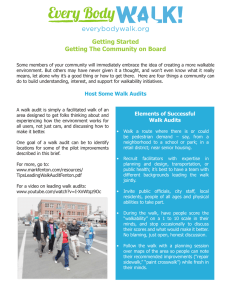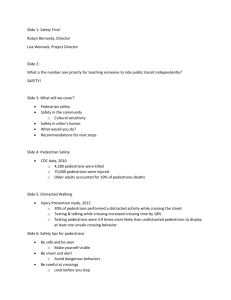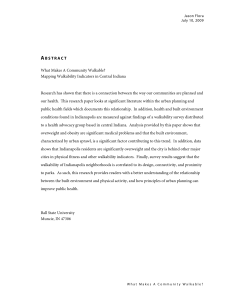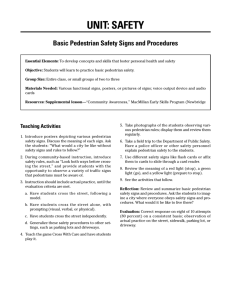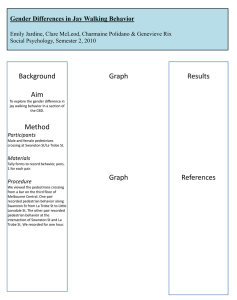Getting Started EveryBody Walk Practice Briefs Summary
advertisement
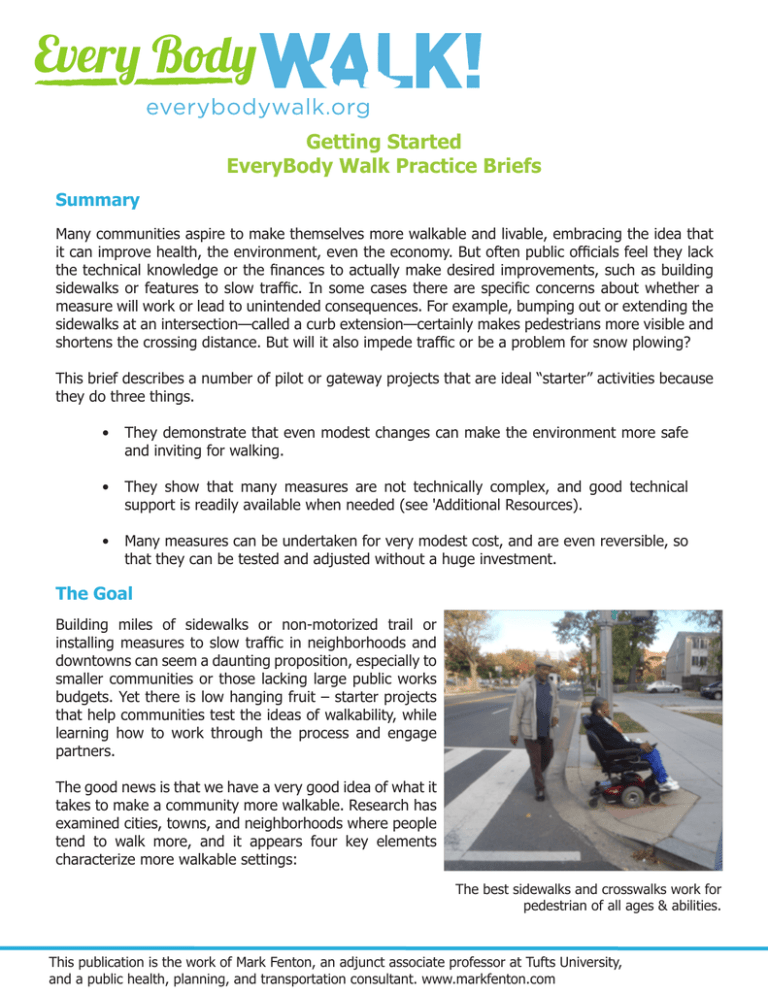
Getting Started EveryBody Walk Practice Briefs Summary Many communities aspire to make themselves more walkable and livable, embracing the idea that it can improve health, the environment, even the economy. But often public officials feel they lack the technical knowledge or the finances to actually make desired improvements, such as building sidewalks or features to slow traffic. In some cases there are specific concerns about whether a measure will work or lead to unintended consequences. For example, bumping out or extending the sidewalks at an intersection—called a curb extension—certainly makes pedestrians more visible and shortens the crossing distance. But will it also impede traffic or be a problem for snow plowing? This brief describes a number of pilot or gateway projects that are ideal “starter” activities because they do three things. • They demonstrate that even modest changes can make the environment more safe and inviting for walking. • They show that many measures are not technically complex, and good technical support is readily available when needed (see 'Additional Resources). • Many measures can be undertaken for very modest cost, and are even reversible, so that they can be tested and adjusted without a huge investment. The Goal Building miles of sidewalks or non-motorized trail or installing measures to slow traffic in neighborhoods and downtowns can seem a daunting proposition, especially to smaller communities or those lacking large public works budgets. Yet there is low hanging fruit – starter projects that help communities test the ideas of walkability, while learning how to work through the process and engage partners. The good news is that we have a very good idea of what it takes to make a community more walkable. Research has examined cities, towns, and neighborhoods where people tend to walk more, and it appears four key elements characterize more walkable settings: The best sidewalks and crosswalks work for pedestrian of all ages & abilities. This publication is the work of Mark Fenton, an adjunct associate professor at Tufts University, and a public health, planning, and transportation consultant. www.markfenton.com • Safety and access. Facilities are fully accessible to those of all ages and abilities (e.g. curb ramps at intersections, wide enough sidewalks without daunting side slopes), and are safe from both traffic and crime. Traffic calming measures slow vehicles and reduce distracted driving, and lighting, building design, visibility, and the presence of other people make everyone feel and be safer. • Variety of uses and activities. Different types of destinations (housing, shopping, recreation, schools, businesses) are close together rather than spread apart. Planners call this a mix of land uses. • Network. A complete and connected network of facilities for walking, including sidewalks and multi-use pathways, as well as short links such as connectors between the cul-de-sacs in residential neighborhoods. If there is transit it is reliable, frequent and affordable. • Functional design. Sites are designed to reward rather than punish you for showing up on foot; buildings are up near the sidewalk, not behind large parking lots (and parking is often on-street or behind structures); trees, benches, human scale lighting, even public art create inviting places for pedestrians. First Steps So how to get started? Here are some first things communities can do to prove walkability isn’t impossible, and that it actually makes a difference. Obviously local transportation, public works, planning and safety officials should be involved in choosing the right treatments for your community, and in designing the proper installation for specific locations. But this guide can help you start thinking about some easy opportunities you can try first. We’ve roughly listed them in order of expense and difficulty, from easier and cheaper (such as moving lines that were being painted anyway!) to more costly and challenging. Selling the Triple Bottom Line If you’re pushing for a more walkable community, you either have or inevitably will hear the reasons it can’t be done: “How do we even design this stuff . . .?” “We don’t have the money; it costs too much!” “Nobody walks here anyway . . . why add sidewalks?” This brief lays out a strong case to answer these questions very simply. First, many of the approaches here are simple, well-established designs. For more details there are great resources such as the NACTO design guides. Second, these are generally low-cost approaches, many of which can be implemented when other work (such as street painting, repair, or repaving projects, or other utility work such as sewer and water lines) is being done. Third, the apparent lack of pedestrians now is usually the result of missing or inadequate facilities, unsafe conditions, and the unfortunate fact that many people simply don’t see the pedestrians who are there despite the challenges. Despite all this, some people will still need convincing. Remind them of the triple bottom line that walkability delivers: healthy people, prosperity, and planet! Start with Paint Narrow the Lanes. Many communities created 12 foot travel lanes for cars simply because it was a recommended standard. Increasingly they’ve realized wide lanes invite speed, and in neighborhoods, retail districts, and near schools narrower lanes send a better message to drivers—in some cases as narrow as 9.5 to 10 feet. Moving existing lane lines can be done most cost efficiently when a street is being painted or repaved as part of routine maintenance. Paint defines a widened-shoulder or bike lane, buffering the pedestrian from the travel lane in Hawai`i. Paint Lines Where They Are Missing. A curb or shoulder line, or if wide enough (five feet) a bicycle lane, can buffer sidewalks and make people feel and be safer. Note that adding on-street bicycle facilities not only improves conditions for cyclists, but can reduce conflicts if fewer cyclists end up riding on the sidewalk! Thus, even adding sharrows (a shared-use arrow) on slower speed, lowtraffic roads can benefit both cyclists and pedestrians. Create an On-Street Walkway. Not an ideal treatment for high traffic volume or highspeed roadways, but creating a walkway with paint, curbing material, even removable bollards can make pedestrians much safer when there is no other sidewalk. Of course paint can also dramatically improve crosswalk visibility. A pedestrian walkway on a quieter street in downtown Boone, NC. A ladder or “piano key” crosswalk, Ann Arbor, MI Improve Way-Finding Including signs along primary walkways that show the route to key destinations is invaluable to pedestrians. Consider using time rather than distance to locations (e.g. 7 minutes rather 0.3 miles) to guide inexperienced walkers. Left: Light-hearted way-finding along the Pinellas trail in Florida. Right: Pedestrian way-finding: Circles represent a 5, 10, and 20 minute walk from ‘you are here’ at center. DelRay Beach, FL. Make Crossing Safer Make Crosswalks More Visible. Simply painting crosswalks where they are missing can be beneficial, but making them highly visible can be even more effective. Ladder or ‘piano key’ stripes with retroreflective paint not only are highly visible in dark and wet conditions, but they may need to be repainted less frequently if aligned so that vehicle tires tend to track between the painted stripes. Add Pedestrian Crossing Signs. High visibility pedestrian crossing signs can dramatically improve drivers’ awareness of a crosswalk. These include advance warnings before the crossing, signs at the side of the crossing, and ‘yield to pedestrian’ signs in the roadway (such as on a median island or curb extension). Selling the Triple Bottom Line People Bottom Left: Pedestrian crossing sign. Yield-to-Pedestrian signs at the center (Top) and the side (Bottom Right) of a crosswalk. Health guidelines suggest all adults should average at least 30 minutes of moderate physical activity a day; youth need a minimum of 60 minutes a day, and everyone benefits from more. It doesn’t have to be formal exercise or gotten all at once: a walk to school or work, to a friend’s, or to the bus stop all help to reduce risk for chronic disease and an early death. And studies show that physical activity supports mental and emotional health too, as active people are at lower risk of clinical depression and even dementia in old age. www.health.gov/ paguidelines/ Create Curb Extensions (Bump Outs). Extending the sidewalk at an intersection is great for drivers and pedestrians. Crossing pedestrians are more visible before stepping out, turning vehicles are slowed, and the crossing distance is shortened so that pedestrians are in the roadway for less time. Though pouring concrete and changing drainage can be costly, initial curb extensions have been created with paint, removable curbing, reflective bollards, signs, even planters. All of these allow a community to test the effectiveness at low cost and redesign as necessary. Curbing and signs, Billings, MT. Paint and flexible, reflective bollards, Queens, NY. Add Street Furniture Everything from benches to trash cans to bike racks can make walkways more appealing, but also more functional by creating a clear “walking zone” on the sidewalk. They also can provide seating, bike parking out of the walkway, trash receptacles, and shade trees, making walking more appealing to everyone, but especially older adults and those with mobility impairments. In many communities businesses and other groups sponsor benches and bike racks. Businesses, families, and service groups designed benches as part of a civic art program in Tinley Park, IL (left). In Brockport, NY (right) sponsors purchased benches throughout downtown. Put Bicycle Parking in Curb Extensions Selling the Triple Bottom Line Prosperity A design contest chose this iconic bike rack for Columbus, IN. Bike parking utilizes the curb extension and keeps sidewalks clear in Columbia, MO. If the sidewalk is too cluttered, combine two ideas by putting bicycle parking in the curb extensions to get it off of the sidewalk, while increasing visibility for pedestrians, cyclists, and motorists, utilizing and defining the bump out, and making everyone safer. Build a Parklet This parklet in Montpelier VT was constructed by students from a nearby vocational school; it’s removed in winter to ease snow removal. This parklet supports local business by providing on-street café seating in Park City, Utah. This is typically a wooden structure that is level with the sidewalk and extends into one or two parking spaces at the sidewalk’s edge. They range from a simple deck, to a seating area with planters or art, to café-style seating. In some communities they are sponsored and even maintained by adjoining businesses. Parklets are often designed to be moved, or removed seasonally The business benefits of a physically active community are almost too many to mention. Physically active employees are absent less, more productive, less costly, and have better attitudes toward their employers. Studies show that housing values (when comparing equivalent homes in the same community) are higher in neighborhoods with higher walkscores, a measures of walkability. Studies suggest developers are increasingly interested in building or redeveloping more walkable settings as development costs can be lower (designs tend to be more compact, with less spent on roads and utilities), there is more flexibility in mixeduse designs (variety of housing types near to and even above businesses and retail), and there is a so called “walkability premium” because walkable settings are so desirable among home buyers and renters. And more walkable retail districts are more economically robust, as they invite a wider array of consumers due to broader transportation choices (walk, bike, transit, drive), and are settings in which those consumers are happy to linger. www.walkscore.com www.ceosforcities.org/ research/walking-the-walk/ www.epa.gov/smartgrowth/ economic_success.htm Make Better Transit Stops A good transit stop is more than a sign on a post; ideally it includes a weather resistant pad, bench, shelter, schedule and route map, a trash can, perhaps even public art. Some include a bike rack, and much of this can be accomplished through local sponsorship by nearby institutions. And safe street crossings nearby are critically important to assure riders can safely walk to their stops! Iconic transit stop in Park City, UT; at the library, of course. Improve a Worn Path or "Goat Trail" Worn pathways, or desire lines, are sure signs of pedestrian demand. And given that enough people walk there to have worn a trail, these may be the easiest place to build a path or sidewalk. If too expensive to install concrete or asphalt, consider starting with gravel to at least stabilize erosion and improve walkability when wet. But these are often found in broken sections of the sidewalk network, and they should be priority sections of sidewalk to complete—especially bridging the short gaps! Complete a Road Diet- Possibly with Just Paint! Many four and five lane roads (two travel lanes in each direction) suffer from frequent collisions and delays, as left turning vehicles must cross two-lanes of on-coming traffic. When stopping to turn they often force following cars to go around them, creating delays and collisions. Engineers have learned that reducing the road to three lanes (a center turn lane with one lane in each direction) in many cases reduces collisions, carries as much traffic, and leaves room for bike lanes and occasional center median islands, making roads that are much safer for pedestrians to cross. Philo Road in Urbana, IL before (left) and after a road diet (right). Calm Traffic with Mini-Circles or Median Islands Neighborhoods concerned with speedy cut-through traffic often request speed bumps and stop signs, both of which have challenges: bumps can be challenging for snow plow drivers, and stop signs cause vehicles to stop and idle even when there is no crossing traffic. For comparable cost to speed bumps, simple median (center) islands or mini-circles Selling the Triple tend to deflect and slow vehicles without damaging them or Bottom Line frustrating drivers. Planet Note the mountable or “roll-over” curb so that occasional large trucks can easily pass this mini-circle in a Madison, WI neighborhood (left). This median island in Louisville, KY (right) is combined with small curb extensions to slightly deflect and slow traffic entering a residential neighborhood. Replace TIA with MMTA Replace TIA with MMTA. This is the wonkiest idea, but it’s also the cheapest! When development and redevelopment is occurring, many communities require a Traffic Impact Analysis (TIA). The developer estimates the number of car trips that will be generated by a new store, say, and recommends mitigation; the addition of a signal light and turning lane, for example. Now more and more communities are instead requiring a Multi-Modal Transportation Analysis (MMTA) in which potential pedestrian, bicycle, and transit trips are also estimated. This way, improvements for all four modes can be considered such as extending walkways, adding bicycle parking, or improving transit stops and access. Though often a simple procedural change in the planning and zoning office, the MMTA can change the “walkability” of development dramatically. At their heart walkable designs are healthier for the environment. More walking and transit trips can mean fewer driving trips, and commensurate decreases in congestion, adverse air and water quality impacts, and greenhouse gas emissions. But subtle elements matter too. For example, the tree canopy we love as walkers also lowers the heat island effect in urban settings. Smaller parking lots in walkable retail, business, and residential settings generate less storm water run-off. Greenbelt trails in suburban and urban settings can help with storm water retention and act as wildlife corridors. The bottom line—more walkable communities are more sustainable in the long run. www.epa.gov/ smartgrowth/partnership/ tools The data for this manuscript came from key informant interviews with twelve long-term practitioners in the field of walkability. The document builds on the practice wisdom of these “elders” and includes expertize from traffic engineers, public health professionals, urban planners, elected officials and law enforcement.
